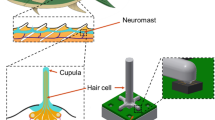Abstract
An artificial hair cell sensor is the current technology based on a biological inspiration and is widely used in underwater applications including the glider, robotic and autonomous surface vehicle. These papers discuss a few strategies in relation to the principles of sensing, fabrication, performance, and preliminary measurement data. The MEMS flow sensor is generally needed to replace existing commercial sensors that are inadequate for some applications. Material also provides some advantages to the hair cell sensor. Some materials such as Polydimethylsilaxone and Polyurethane have been investigated. The sensing element is reviewed including the doped piezoresistors, strain gauge and force sensitive resistors. Performance and result of each design will be presented briefly. Finally, the importance and the need for modeling, simulation and experiments will be reviewed based on the latest achievements on that particular research area.














Similar content being viewed by others
References
Arshad MR (2009) Recent advancement in sensor technology for underwater applications. Indian J Marine Sci 38(3):267–273
Ashauer MH, Glosch H, Hedrich F, Hey N, Sandmaier H, Lang W (1998) Thermal flow sensor for liquids and gases. In: Proceedings of the international workshop on micro electro mechanical systems (MEMS’98). Heidelberg, Germany, pp 351–355
Bond CE (1996) Biology of fishes, 2nd edn. Saunders, Philadelphia
Bratov JM, Dominguez C, Bartroli J (1995) Photocurable polymers applied as encapsulating materials for ISFET production. Sens Actuators B 25:823–825
Campolo D, Jones SD, Fearing RS (2003) Fabrication of gecko foot-hair like nano structures and adhesion to random rough surfaces. Presented at IEEE Conference on Nanotechnology
Chen J, Jonathan ME, Liu C (2003) Development of polymer-based artificial haircell using surface micromachining and 3D assembly. 12th international conference on solid-state sensors, actuators and microsystems, Boston
Coombs S (2001) Smart skins: information processing by lateral line flow sensors. Auton Robot 11:255–261
Dijkstra M, van Barr JJ, Wiegerink RJ, Lammerink TSJ, de Boer JH, Krijnen GJM (2005) Artificial sensory hairs based on the flow sensitive receptor hairs of crickets. J Micromech Microeng 15:132–138
Ebefors T, Kalvesten E, Stemme G (1998) Three dimensional silicon triple-hot-wire anemometer based on polyimide joints. In: Proceedings of the IEEE MEMS'98, Jan 25–29, Heidelberg, Germany, pp 93–98
Engel JM, Chen J, Chen N, Pandya S, Liu C (2005a) Development and characterization of an artificial hair cell based on polyurethane elastomer and force sensitive resistors. In: The 4th IEEE international conference on sensors, Irvine, California, 31 Oct–1 Nov
Engel JM, Chen J, Bullen D, Liu C (2005b) Polyurethane rubber as a MEMS material: characterization and demonstration of an all-polymer two-axis artificial hair cell flow sensor. In: IEEE international conference on micro electro mechanical systems (MEMS), pp 279–282
Fan Z, Chen J, Zou J, Bullen D, Liu C, Delcomyn F (2002) Design and fabrication of artificial lateral line flow sensor. J Micromech Microeng 12:655–661
Freymuth P (1979) Engineering estimation of heat conduction loss in constant temperature thermal sensors. TSI Quarterly 3:3–9
Hu H, Liu C, Chen N (2008) A robust tactile shear stress sensor derived from a bio-inspired artificial haircell sensor. IEEE sensors conference, pp 1135–1138
Lammerink TSJ, Elwenspoek M, Fluitman JHJ (1993) Micro-liquid flow sensor. Sens Actuators A 37:45–50
Lammerink TSJ, Spiering VL, Elwenspoek M, Fluitman JHJ, van den Berg A (1996) Modular concept for fluid handling systems. A demonstrator micro analysis system. In: Proceedings of the international workshop on micro electro mechanical systems (MEMS’96), San Diego, pp 389–394
Li JD (2004) Dynamic response of constant temperature hot-wire system in turbulent velocity measurements. Meas Sci Technol 15:1835–1847
Li J, Chen J, Liu C (2000) Micromachined biomimetic sensor using modular artificial hair cells. NanoSpace 2000, Houston
Liu Y, Chen L, Sun L (2009) A MEMS flow sensor and its application in adaptive liquid dispensing. International conference on measuring technology and mechatronics automation
Melani M, Lorenzo B, De Marinis M, Peter L, D’Ascoli F, Fanucci L (2008) Hot wire anemometric MEMS sensor for water flow monitoring. Automation and Test in Europe, Munich, pp 10–14
Meyer J-U, Biehl M (1995) Micropatterned biocompatible materials with applications for cell cultivation. J Micromech Microeng 5:172–174
Morris SC, Foss JF (2003) Transient thermal response of a hot-wire anemometer. Meas Sci Technol 14:251–259
Ryu KS, Wang X, Shaikh K, Liu C (2004) A method for precision patterning of silicone elastomer and its applications. J Microelectromech Syst 13(5):68–75
Wu S, Lin Q, Yuen Y, Tai Y-C (2001) MEMS flow sensors for nano-fluidic applications. Sens Actuator 89:152–158
White FM (1999) Fluid mechanics. New York, McGraw Hill
Yunus AC, John MC (2006) Fluid mechanics, fundamentals and applications, 1st edn in SI Units. McGraw Hill
Zou J, Chen J, Liu C, Schutt-Aine JE (2001) Plastic deformation magnetic assembly (PDMA) of out-of-planemicrostructures: technology and application. J Microelectromech Syst 10:302–309
Acknowledgments
The author is a USM fellowship holder. This study was supported by short term grant number 304/PELECT/60310023 and grant number 304/PELECT/6050124.
Author information
Authors and Affiliations
Corresponding author
Rights and permissions
About this article
Cite this article
Mat Nawi, M.N., Manaf, A.A., Arshad, M.R. et al. Review of MEMS flow sensors based on artificial hair cell sensor. Microsyst Technol 17, 1417–1426 (2011). https://doi.org/10.1007/s00542-011-1330-y
Received:
Accepted:
Published:
Issue Date:
DOI: https://doi.org/10.1007/s00542-011-1330-y




